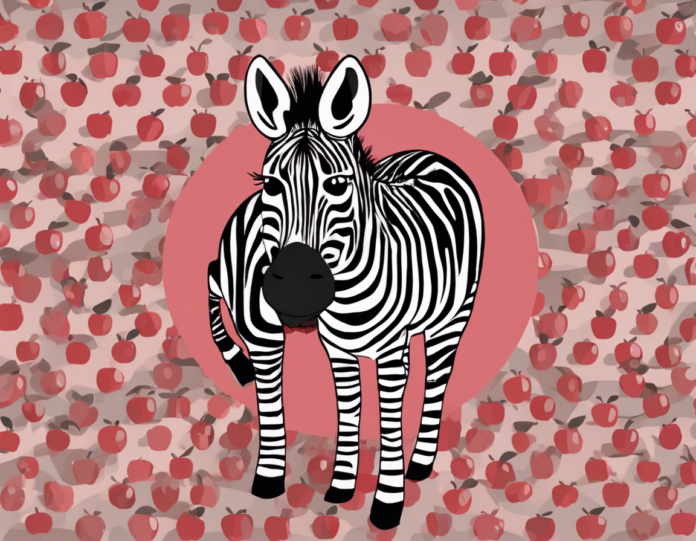Are you ready to embark on a journey through the alphabet from A for Apple to Z for Zebra? Let’s delve into this exciting adventure and explore the world of English alphabet in a fun and educational way.
A is for Apple:
Let’s kick things off with A for Apple. An apple is a delicious and nutritious fruit that comes in various colors and flavors. It is a popular fruit eaten raw or used in cooking and baking. Did you know that there are over 7,500 different types of apples grown worldwide?
B is for Butterfly:
Moving on to B for Butterfly, these colorful insects are known for their beautiful wings and graceful flight. Butterflies undergo a remarkable transformation called metamorphosis, changing from a caterpillar to a chrysalis and finally emerging as a stunning butterfly.
C is for Cat:
C for Cat introduces us to one of the most popular pets around the world. Cats are known for their agility, independence, and affectionate nature. With their whiskers, sharp claws, and keen senses, cats are excellent hunters and beloved companions.
D is for Dolphin:
D for Dolphin takes us under the sea to meet these intelligent marine mammals. Dolphins are known for their playful behavior, acrobatic skills, and strong social bonds. They communicate through a series of clicks, whistles, and body language.
E is for Elephant:
E for Elephant introduces us to the largest land animals on Earth. Elephants are known for their massive size, long tusks, and trunk, which they use for various activities such as eating, drinking, and communicating with each other. These gentle giants are highly intelligent and have exceptional memories.
F is for Firefly:
F for Firefly sheds light on these enchanting insects known for their bioluminescent glow. Fireflies use their glowing abdomens to communicate, attract mates, and defend themselves. Their magical nighttime displays have captivated people for centuries.
G is for Giraffe:
G for Giraffe takes us to the African savannas to meet these elegant creatures with long necks and distinctive coat patterns. Giraffes are well adapted to browsing leaves from tall trees and use their height to spot predators from afar. Did you know that a giraffe’s neck can reach up to 6 feet in length?
H is for Honeybee:
H for Honeybee introduces us to these industrious insects essential for pollinating flowers and producing honey. Honeybees live in highly organized colonies with a queen, worker bees, and drones. They perform intricate waggle dances to communicate the location of food sources to their fellow bees.
I is for Igloo:
I for Igloo takes us to the icy landscapes of the Arctic, where the Inuit people build these domed shelters using blocks of compacted snow and ice. Igloos provide warmth and protection from the harsh polar conditions, showcasing the ingenuity of indigenous Arctic cultures.
J is for Jaguar:
J for Jaguar brings us to the jungles of South America, where these majestic big cats prowl stealthily through the dense vegetation. Jaguars are powerful predators with distinctive black rosette patterns on their golden coats. They are skilled hunters known for their agility and strength.
K is for Kangaroo:
K for Kangaroo hops into the picture, representing the iconic marsupials of Australia. Kangaroos are known for their powerful hind legs, long tails, and pouches in which they carry their young joeys. These unique animals are built for speed and agility, bounding across the outback with ease.
L is for Lion:
L for Lion introduces us to the “king of the jungle,” with its majestic mane and powerful roar. Lions are social cats that live in prides, with females doing most of the hunting while males defend the territory. These apex predators symbolize strength, courage, and leadership in many cultures.
M is for Moon:
M for Moon takes us to the Earth’s natural satellite that lights up the night sky. The moon plays a vital role in regulating tides, illuminating the darkness, and inspiring myths and legends throughout history. Its phases, from new moon to full moon, captivate observers around the world.
N is for Nightingale:
N for Nightingale serenades us with the melodious songs of these small, elusive birds. Nightingales are known for their powerful and beautiful singing, especially during the nighttime hours. Their enchanting vocal abilities have inspired poets, musicians, and artists for centuries.
O is for Owl:
O for Owl introduces us to these wise and nocturnal birds of prey. Owls are known for their exceptional hearing, silent flight, and keen hunting skills. With their large eyes, sharp talons, and distinctive hoots, owls are fascinating creatures that embody mystery and intelligence.
P is for Penguin:
P for Penguin waddles onto the scene, showcasing these charismatic birds that are highly adapted to life in cold, aquatic environments. Penguins are excellent swimmers and divers, using their flippers to navigate through the water with precision. They form tight-knit colonies and display unique courtship rituals.
Q is for Queen:
Q for Queen brings regal elegance to our alphabet journey. A queen is a female monarch who holds a position of power and authority. Queens have played significant roles throughout history, shaping nations, cultures, and societies with their leadership and influence.
R is for Rainbow:
R for Rainbow introduces the colorful arc that appears in the sky when sunlight is refracted through raindrops. Rainbows symbolize hope, beauty, and promise, captivating observers with their vibrant hues and ethereal appearance. The sequence of colors in a rainbow is Roy G. Biv: red, orange, yellow, green, blue, indigo, and violet.
S is for Sunflower:
S for Sunflower shines bright with these iconic flowers known for their large, sunny blooms and edible seeds. Sunflowers track the movement of the sun throughout the day, a phenomenon called heliotropism. These cheerful flowers are associated with warmth, happiness, and positivity.
T is for Turtle:
T for Turtle introduces us to these ancient reptiles that have roamed the Earth for millions of years. Turtles have hard shells that protect them from predators, and they move slowly on land but gracefully in the water. These resilient creatures symbolize longevity, wisdom, and stability.
U is for Unicorn:
U for Unicorn brings a touch of magic and fantasy to our alphabet journey. Unicorns are mythical creatures with a single horn on their forehead, often depicted as symbols of purity, grace, and enchantment. These legendary creatures have captured the imagination of people throughout history.
V is for Volcano:
V for Volcano erupts onto the scene with these powerful geologic features that shape our planet. Volcanoes are vents in the Earth’s crust through which molten rock, ash, and gases are expelled. Volcanic eruptions can be both destructive and constructive, creating new landforms and influencing the Earth’s climate.
W is for Whale:
W for Whale dives into the depths of the ocean to meet these magnificent marine mammals. Whales are known for their immense size, complex songs, and long migrations across vast oceanic expanses. From the blue whale, the largest animal on Earth, to the acrobatic humpback whale, these creatures inspire awe and admiration.
X is for Xylophone:
X for Xylophone introduces us to this musical instrument with wooden bars that produce melodic tones when struck with mallets. Xylophones are part of percussion ensembles and are popular in orchestras, bands, and classrooms. The xylophone’s bright sound adds rhythm and harmony to musical compositions.
Y is for Yeti:
Y for Yeti ventures into the realm of cryptozoology with this legendary ape-like creature said to inhabit the Himalayan mountains. The Yeti, also known as the “Abominable Snowman,” is a mysterious figure in folklore and popular culture, with reported sightings and stories intriguing adventurers and researchers.
Z is for Zebra:
Finally, Z for Zebra brings us to these striking striped equids found in the grasslands and savannas of Africa. Zebras have black and white stripes that are unique to each individual, serving as camouflage, protection against insects, and social recognition within the herd. These iconic animals symbolize individuality, unity, and the beauty of diversity in nature.
We’ve now completed our journey through the alphabet from A for Apple to Z for Zebra, exploring a diverse range of animals, objects, and concepts along the way. The English alphabet is a gateway to knowledge, creativity, and language, offering endless possibilities for learning and discovery.
Frequently Asked Questions (FAQs)
1. What is the purpose of learning the alphabet?
Learning the alphabet is fundamental to mastering the language, improving reading and writing skills, and enhancing communication abilities. It forms the building blocks for literacy and language acquisition.
2. How can I teach the alphabet to young children?
You can teach the alphabet to young children through interactive games, songs, flashcards, and books. Engaging activities that involve visual, auditory, and kinesthetic learning can make the process fun and effective.
3. Why are phonics important in learning the alphabet?
Phonics involves connecting sounds to letters and plays a crucial role in developing early reading skills. Understanding phonics helps children decode words, build vocabulary, and improve reading fluency.
4. Are there different alphabets in the world?
Yes, there are various alphabets used in different languages and writing systems worldwide. Examples include the Cyrillic alphabet, Greek alphabet, Arabic script, and Chinese characters, each with its unique symbols and rules.
5. How can I improve my alphabet recognition and fluency?
Practicing regularly, using mnemonic devices, engaging in alphabet-themed activities, and incorporating letters into daily routines can help improve alphabet recognition and fluency. Consistent practice and reinforcement are key to mastery.
6. What are some creative ways to reinforce alphabet learning?
Creative ways to reinforce alphabet learning include alphabet scavenger hunts, letter-themed crafts, alphabet yoga poses, alphabet baking or cooking activities, and alphabet storybook adventures. Making learning interactive and engaging enhances retention and enjoyment.
7. How does learning the alphabet benefit cognitive development?
Learning the alphabet enhances cognitive development by improving memory, attention, sequencing skills, and symbolic thinking. It lays the foundation for language acquisition, problem-solving, and critical thinking abilities in children and adults.
8. What are some common alphabet-related challenges and how to overcome them?
Common alphabet-related challenges include letter reversals, confusion between similar letters, and difficulty with letter-sound associations. Overcoming these challenges involves targeted practice, multisensory approaches, positive reinforcement, and addressing underlying learning differences.
9. How can adults improve their alphabet skills if they struggle with literacy?
Adults who struggle with literacy can improve their alphabet skills through adult education programs, literacy courses, online resources, tutoring, and supportive learning environments. It’s never too late to enhance literacy skills and unlock new opportunities for personal and professional growth.
10. Why is it important to celebrate the diversity of the alphabet?
Celebrating the diversity of the alphabet showcases the richness of human languages, cultures, and traditions worldwide. Embracing linguistic diversity fosters inclusivity, understanding, and appreciation for the myriad ways in which people communicate and express themselves through written symbols.
Exploring the alphabet from A for Apple to Z for Zebra opens up a world of learning, creativity, and discovery. Whether you’re a young learner beginning your literacy journey or an adult looking to enhance your language skills, the alphabet offers endless possibilities for growth and exploration. Embrace the power of the alphabet and unlock its magic in your educational endeavors.


